Classification of Standing and Walking States Using Ground Reaction Forces
Abstract
1. Introduction
2. Methods
2.1. Hardware Description
2.2. Participants
2.3. Test Method
2.4. Selection and Evaluation of Factors
2.4.1. Candidate Factors to Overcome Errors Caused by Foot Drop
2.4.2. Selection of Factor Based on Approximate Entropy
2.4.3. Waveform Length of
2.5. Classification of Standing and Walking States
2.5.1. Threshold Method
Timing Analysis Module (TAM) Method, Using the GRF Threshold
Using Threshold
2.5.2. Artificial Neural Network Model
3. Results
3.1. State Classification Accuracy When Using Threshold Methods
3.2. State Classification Accuracy by Machine Learning
4. Discussion
5. Conclusions
Author Contributions
Funding
Institutional Review Board Statement
Informed Consent Statement
Data Availability Statement
Conflicts of Interest
Appendix A

| No. | Position | x | y |
|---|---|---|---|
| 1 | Toe, Left | ||
| 2 | 1st Metatarsal, Left | ||
| 3 | 5th Metatarsal, Left | ||
| 4 | Cuboid, Left | ||
| 5 | Heel, Left | ||
| 6 | Toe, Right | ||
| 7 | 1st Metatarsal, Right | ||
| 8 | 5th Metatarsal, Right | ||
| 9 | Cuboid, Right | ||
| 10 | Heel, Right | ||
Appendix B

References
- Sudarsky, L. Gait disorders: Prevalence, morbidity, and etiology. Adv. Neurol. 2001, 87, 111–117. [Google Scholar]
- Jørgensen, H.S.; Nakayama, H.; Raaschou, H.O.; Olsen, T.S. Recovery of walking function in stroke patients: The COPenhagen stroke study. Arch. Phys. Med. Rehabil. 1995, 76, 27–32. [Google Scholar] [CrossRef]
- Hassan, M.; Kadone, H.; Suzuki, K.; Sankai, Y. Exoskeleton robot control based on cane and body joint synergies. In Proceedings of the 2012 IEEE/RSJ International Conference on Intelligent Robots and Systems, Vilamoura-Algarve, Portugal, 7–12 October 2012; IEEE: New York, NY, USA, 2012; pp. 1609–1614. [Google Scholar]
- Chen, J.; Zhang, X.; Wang, H.; Shi, Q.; Li, R. Control strategies for lower limb rehabilitation robot. In Proceedings of the 2014 IEEE International Conference on Information and Automation (ICIA), Hailar, China, 28–30 July 2014; IEEE: New York, NY, USA, 2014; pp. 121–125. [Google Scholar]
- Tang, J.; Zheng, J.; Wang, Y.; Yu, L.; Zhan, E.; Song, Q. Self-Tuning Threshold Method for Real-Time Gait Phase Detection Based on Ground Contact Forces Using FSRs. Sensors 2018, 18, 481. [Google Scholar] [CrossRef] [PubMed]
- Mariani, B.; Rouhani, H.; Crevoisier, X.; Aminian, K. Quantitative estimation of foot-flat and stance phase of gait using foot-worn inertial sensors. Gait Posture 2013, 37, 229–234. [Google Scholar] [CrossRef] [PubMed]
- Catalfamo, P.; Moser, D.; Ghoussayni, S.; Ewins, D. Detection of gait events using an F-Scan in-shoe pressure measurement system. Gait Posture 2008, 28, 420–426. [Google Scholar] [CrossRef]
- Yu, L.; Zheng, J.; Wang, Y.; Song, Z.; Zhan, E. Adaptive method for real-time gait phase detection based on ground contact forces. Gait Posture 2015, 41, 269–275. [Google Scholar] [CrossRef]
- Park, J.S.; Lee, C.M.; Koo, S.-M.; Kim, C.H. Gait Phase Detection Using Force Sensing Resistors. IEEE Sens. J. 2020, 20, 6516–6523. [Google Scholar] [CrossRef]
- Kotiadis, D.; Hermens, H.J.; Veltink, P.H. Inertial gait phase detection for control of a drop foot stimulator: Inertial sensing for gait phase detection. Med. Eng. Phys. 2010, 32, 287–297. [Google Scholar] [CrossRef] [PubMed]
- Mannini, A.; Sabatini, A.M. A hidden Markov model-based technique for gait segmentation using a foot-mounted gyrosCOPe. In Proceedings of the 2011 Annual International Conference of the IEEE Engineering in Medicine and Biology Society, Boston, MA, USA, 30 August–3 September 2011; IEEE: New York, NY, USA, 2011; Volume 2011, pp. 4369–4373. [Google Scholar]
- Selles, R.W.; Formanoy, M.A.G.; Bussmann, J.B.J.; Janssens, P.J.; Stam, H.J. Automated Estimation of Initial and Terminal Contact Timing Using Accelerometers; Development and Validation in Transtibial Amputees and Controls. IEEE Trans. Neural Syst. Rehabil. Eng. 2005, 13, 81–88. [Google Scholar] [CrossRef]
- Willemsen, A.; Bloemhof, F.; Boom, H. Automatic stance-swing phase detection from accelerometer data for peroneal nerve stimulation. IEEE Trans. Biomed. Eng. 1990, 37, 1201–1208. [Google Scholar] [CrossRef] [PubMed]
- Brandell, B.R. Development of a universal control unit for functional electrical stimulation (FES). Am. J. Phys. Med. 1982, 61, 279–301. [Google Scholar] [CrossRef]
- Pappas, I.P.I.; Popovic, M.R.; Keller, T.; Dietz, V.; Morari, M. A reliable gait phase detection system. IEEE Trans. Neural Syst. Rehabil. Eng. 2001, 9, 113–125. [Google Scholar] [CrossRef] [PubMed]
- Mansfield, A.; Lyons, G.M. The use of accelerometry to detect heel contact events for use as a sensor in FES assisted walking. Med. Eng. Phys. 2003, 25, 879–885. [Google Scholar] [CrossRef]
- Jasiewicz, J.M.; Allum, J.H.; Middleton, J.W.; Barriskill, A.; Condie, P.; Purcell, B.; Li, R.C.T. Gait event detection using linear accelerometers or angular velocity transducers in able-bodied and spinal-cord injured individuals. Gait Posture 2006, 24, 502–509. [Google Scholar] [CrossRef]
- Kirkwood, C.; Andrews, B.; Mowforth, P. Automatic detection of gait events: A case study using inductive learning techniques. J. Biomed. Eng. 1989, 11, 511–516. [Google Scholar] [CrossRef]
- Pinkam, N.; Nilkhamhang, I. A wireless smart shoe for gait analysis using heuristic algorithm with automated thresholding. Agric. Nat. Resour. 2013, 47, 909–924. [Google Scholar]
- Bar-Haim, S.; Harries, N.; Hutzler, Y.; Belokopytov, M.; Dobrov, I. Training to walk amid uncertainty with Re-Step: Measurements and changes with perturbation training for hemiparesis and cerebral palsy. Disabil. Rehabil. Assist. Technol. 2013, 8, 417–425. [Google Scholar] [CrossRef]
- Tabakin, D. A Comparison of 3D Gait Models Based on the Helen Hayes Hospital Marker Set. Ph.D. Thesis, University of Cape Town, Cape Town, South African, 2000. [Google Scholar]
- Winter, D.A. Biomechanics and Motor Control of Human Movement, 4th ed.; Wiley: Hoboken, NJ, USA, 2009; Volume 2009. [Google Scholar]
- Webber, C.L., Jr.; Zbilut, J.P. Dynamical assessment of physiological systems and states using recurrence plot strategies. J. Appl. Physiol. 1994, 76, 965–973. [Google Scholar] [CrossRef]
- Schmit, J.M.; Riley, M.A.; Dalvi, A.; Sahay, A.; Shear, P.K.; Shockley, K.D.; Pun, R.Y.K. Deterministic center of pressure patterns characterize postural instability in Parkinson’s disease. Exp. Brain Res. 2005, 168, 357–367. [Google Scholar] [CrossRef]
- Choi, T.; Im, C.-H.; Kim, S.-J.; Kim, H.; Lee, J.M. Prediction Method of Walking Speed at Swing Phase using Soleus Electromyogram Signal at Previous Stance Phase. In Proceedings of the 40th Annual International Conference of the IEEE Engineering in Medicine and Biology Society (EMBC), Honolulu, HI, USA, 18–21 July 2018; IEEE: New York, NY, USA, 2018; Volume 2018, pp. 2308–2311. [Google Scholar]
- Garson, G.D. Interpreting neural-network connection weights. AI Expert 1991, 6, 46–51. [Google Scholar]
- Olden, J.D.; Jackson, D.A. Illuminating the “black box”: A randomization approach for understanding variable contributions in artificial neural networks. Ecol. Model. 2002, 154, 135–150. [Google Scholar] [CrossRef]
- Djamaa, B.; Bessa, M.M.; Diaf, B.; Rouigueb, A.; Yachir, A. BoostSole: Design and realization of a smart insole for automatic human gait classifiaction. In Proceedings of the 15th Conference on Computer Science and Information Systems (FedCSIS), Sofia, Bulgaria, 6–9 September 2020; pp. 35–43. [Google Scholar]
- Dipaola, M. Anticipatory Posture Adjustment of Gait Initiation in Subjects with Neuro-Degenerative Diseases: Experimental Study and Dynamic Model Simulations. Ph.D. Dissertation, Politecnico di Milano, Milano, Italy, 2017. [Google Scholar]
- Schreiber, T.; Schmitz, A. Surrogate time series. Phys. D Nonlinear Phenom. 2000, 142, 346–382. [Google Scholar] [CrossRef]
- Lancaster, G.; Iatsenko, D.; Pidde, A.; Ticcinelli, V.; Stefanovska, A. Surrogate data for hypothesis testing of physical systems. Phys. Rep. 2018, 748, 1–60. [Google Scholar] [CrossRef]
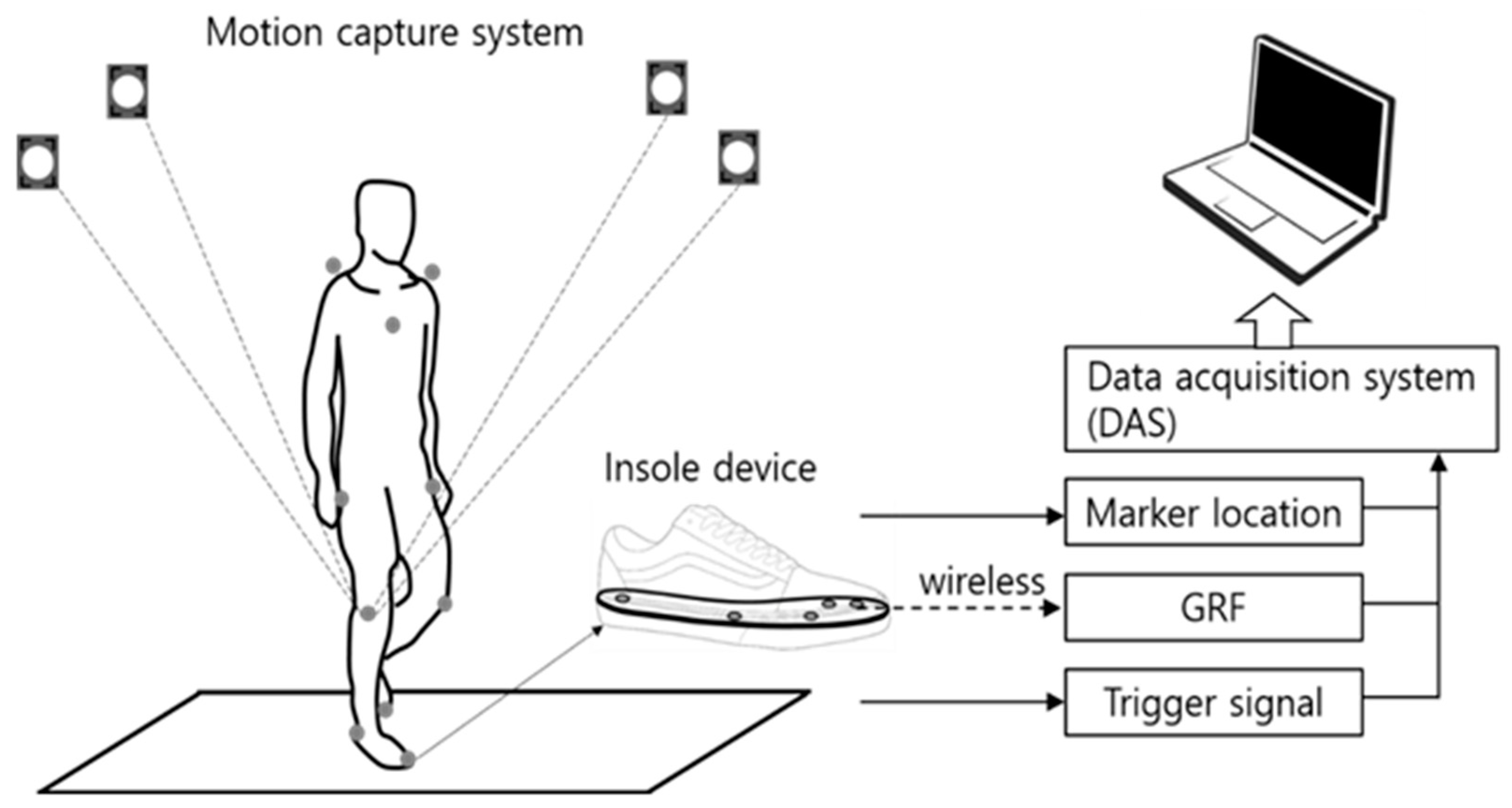

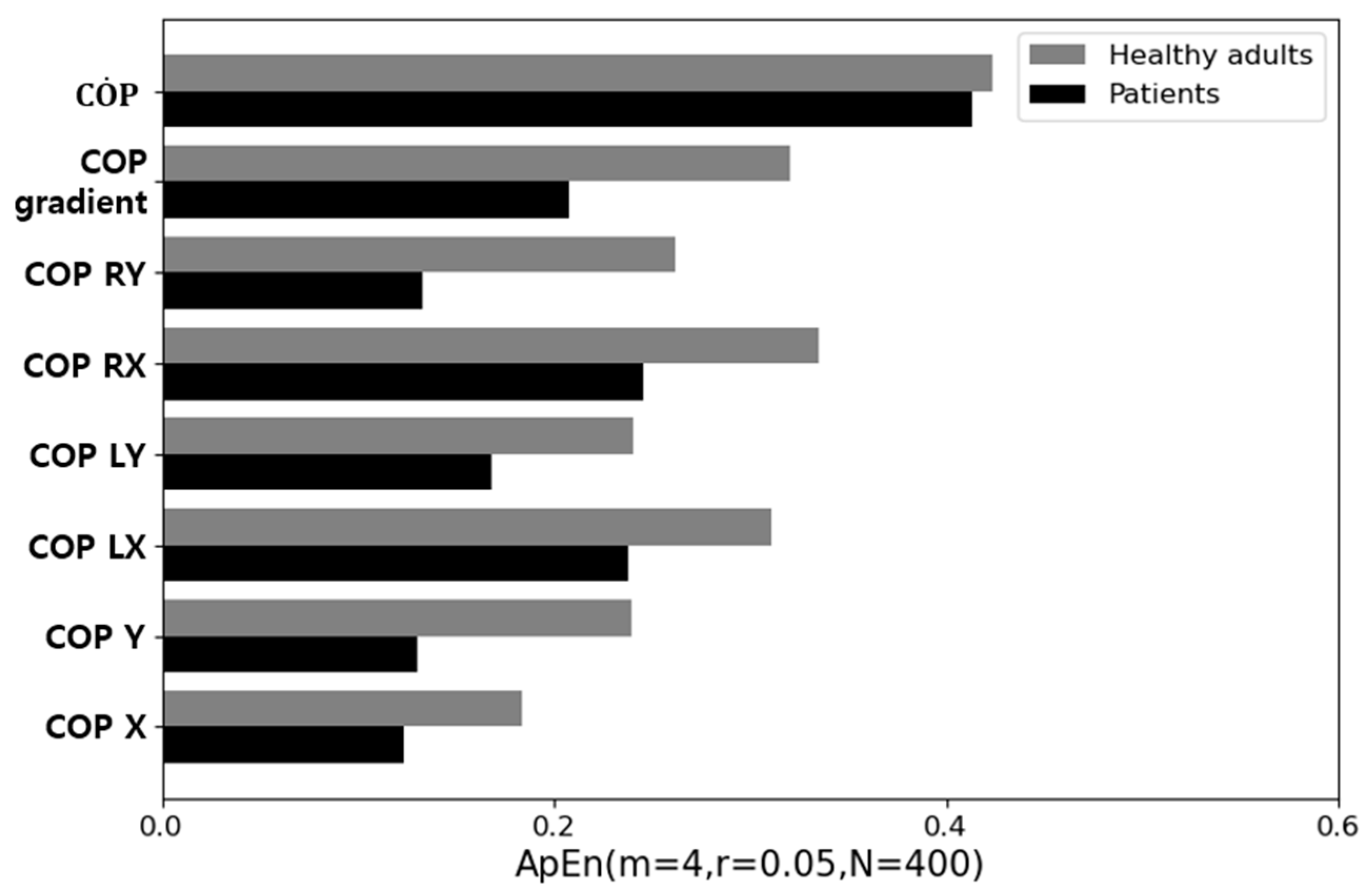
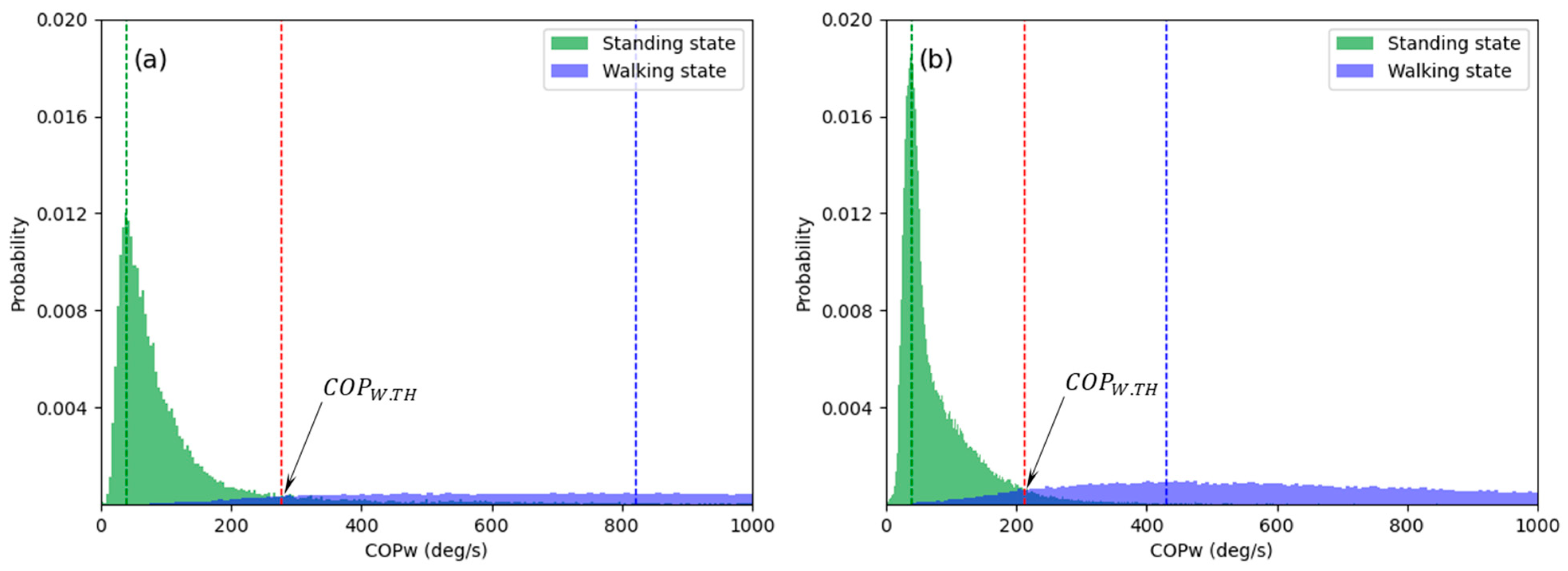


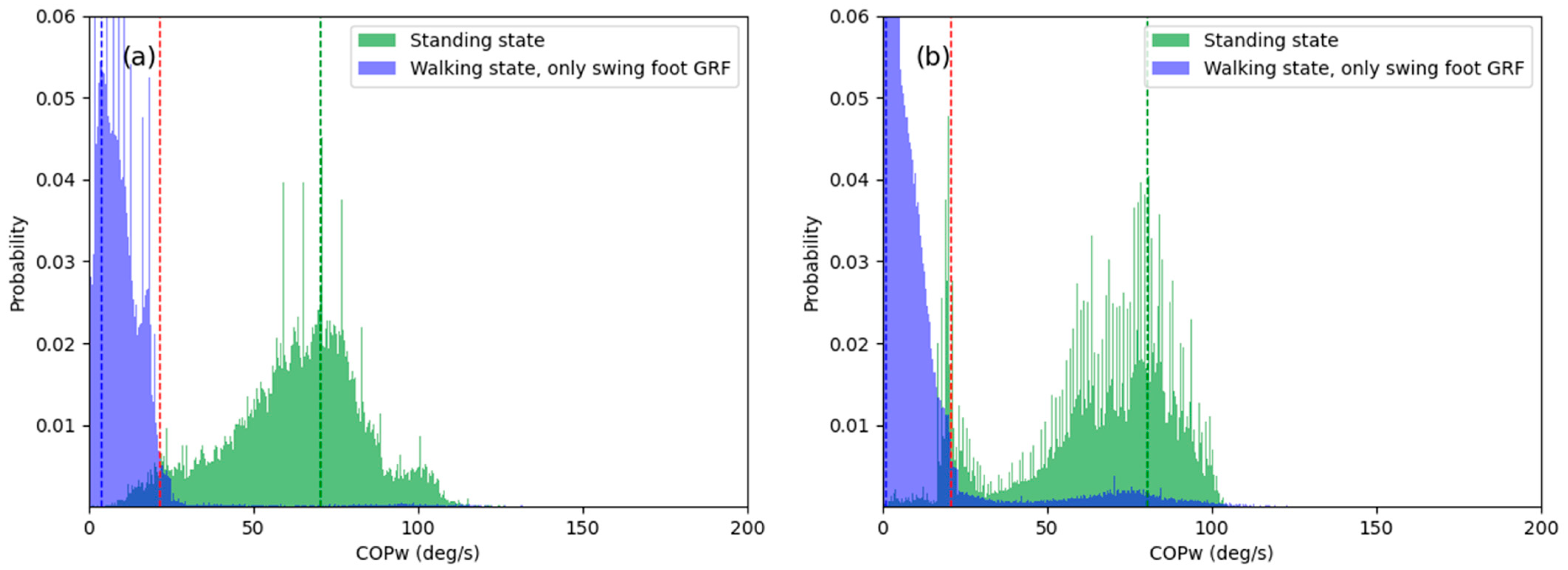
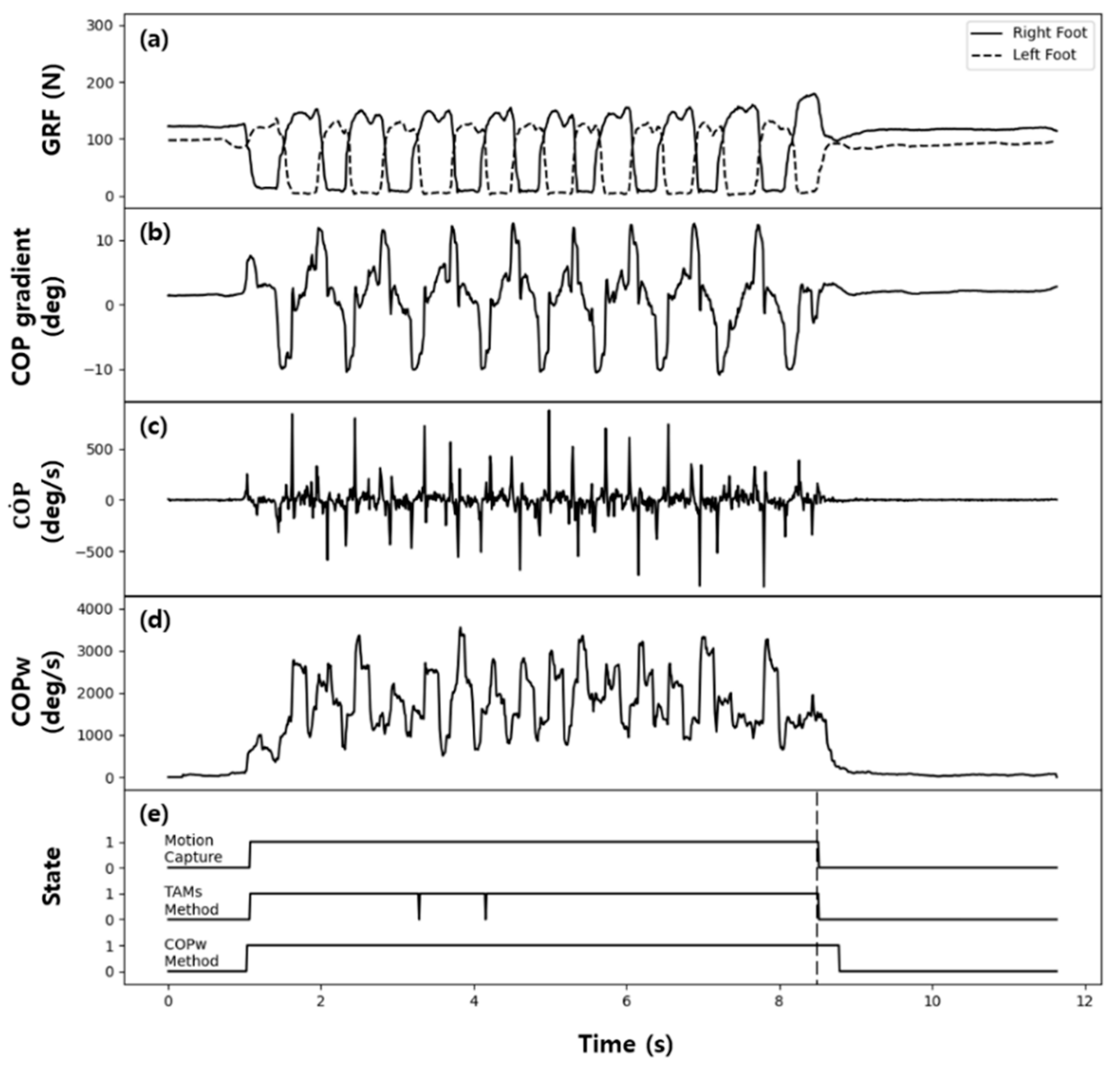
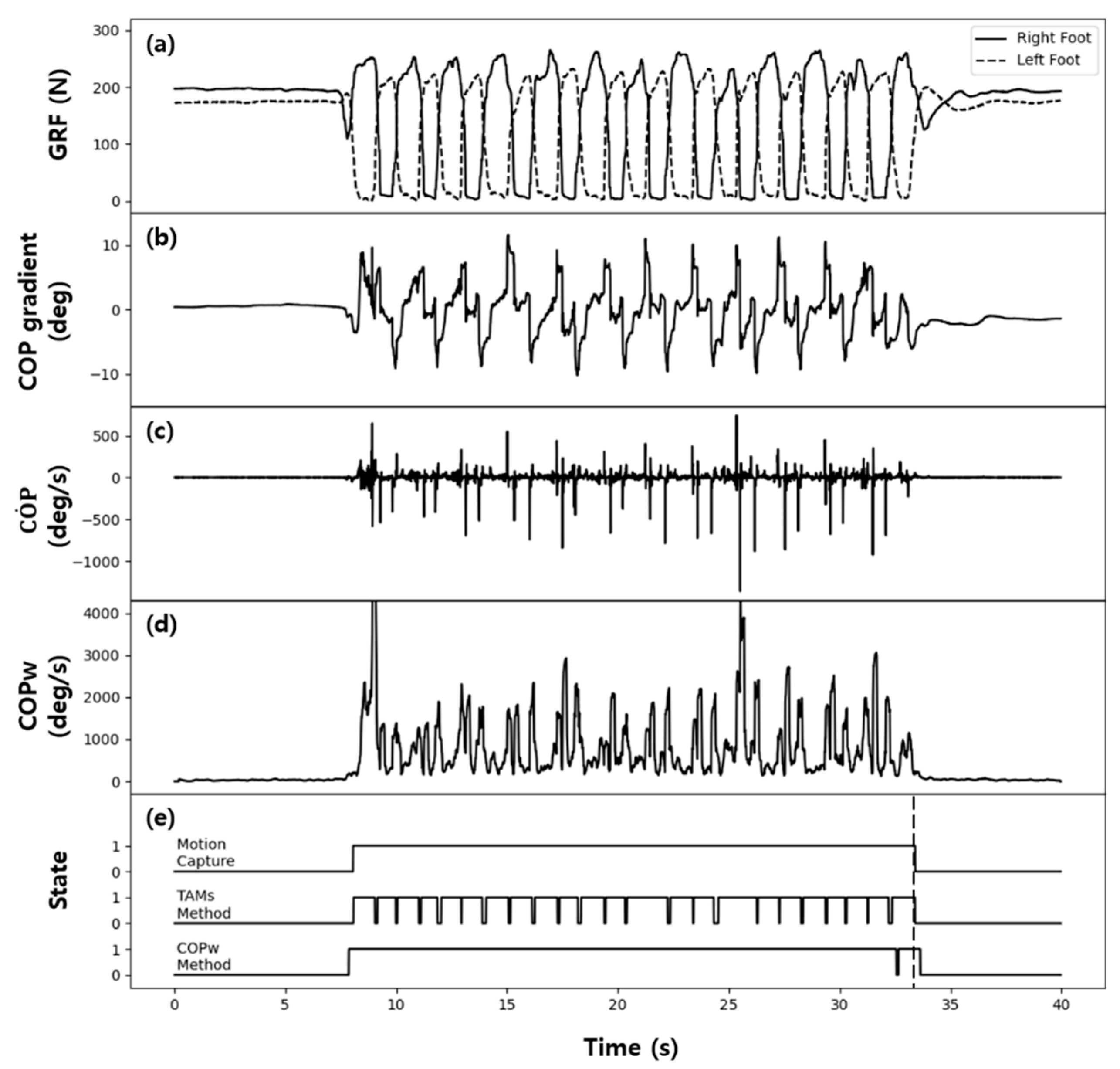

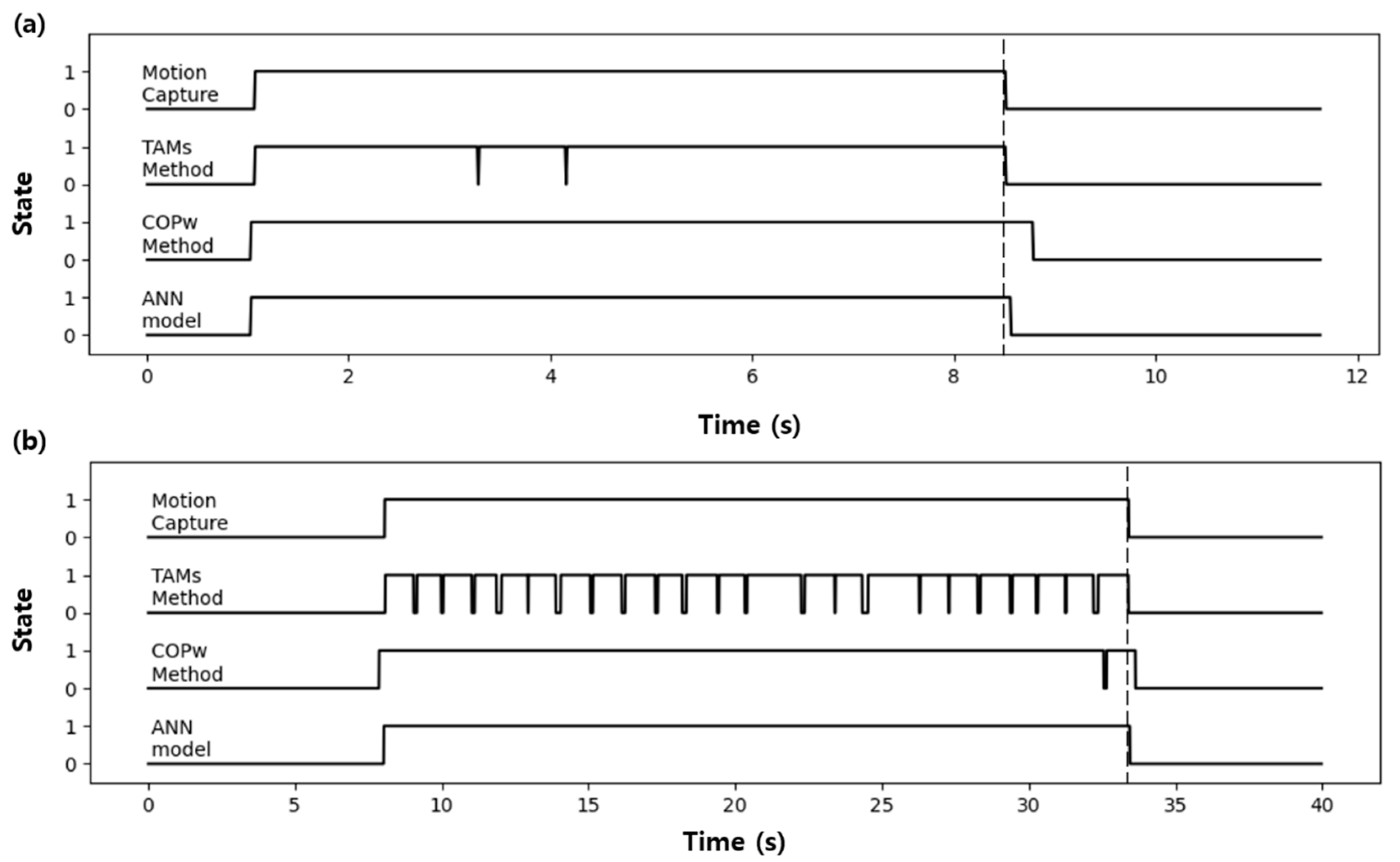
| Condition | Normal, Male | Normal, Female | Patient |
|---|---|---|---|
| Number of persons | 19 | 9 | 4 |
| Age (years) | 25 (S.D. 3) | 21 (S.D. 1) | 56 (S.D. 10) |
| Height (m) | 1.75 (S.D. 0.06) | 1.61 (S.D. 0.04) | 1.67 (S.D. 0.05) |
| Weight (kg) | 68 (S.D. 7) | 51 (S.D. 4) | 68 (S.D. 6) |
| TAM Method | ||||||||
|---|---|---|---|---|---|---|---|---|
| Healthy Adults | Patients | Healthy Adults | Patients | |||||
| Standing | Walking | Standing | Walking | Standing | Walking | Standing | Walking | |
| Threshold value | 21 (N) | 20 (N) | 276 (deg/s) | 212 (deg/s) | ||||
| Mode value | 70 (N) | 3 (N) | 80 (N) | 1 (N) | 38 (deg/s) | 820 (deg/s) | 39 (deg/s) | 430 (deg/s) |
| Percentile | 3.73% | 96.00% | 9.00% | 89.50% | 90.00% | 4.00% | 94.50% | 5.50% |
| Classification accuracy | 98.40% | 98.56% | 96.63% | 87.22% | 91.26% | 97.40% | 94.52% | 95.50% |
| Healthy Adults | Patients | ||||||
|---|---|---|---|---|---|---|---|
| Walking Speed (m/s) | 0.83 ± 0.08 | 0.29 ± 0.06 | |||||
| Method | Threshold method | ANN | Threshold method | ANN | |||
| GRF | GRF | ||||||
| Time delay (ms) | at start of walking | −11.8 ± 7.8 | −24.8 ± 21.7 | 3.2 ± 10.1 | 52.1 ± 26.1 | −155.5 ± 97.2 | −9.0 ± 13.9 |
| at stop of walking | −2.6 ± 12.4 | 193.3 ± 52.3 | 2.9 ± 9.3 | −283.4 ± 104.7 | 139.3 ± 74.2 | −3.9 ± 3.8 | |
Publisher’s Note: MDPI stays neutral with regard to jurisdictional claims in published maps and institutional affiliations. |
© 2021 by the authors. Licensee MDPI, Basel, Switzerland. This article is an open access article distributed under the terms and conditions of the Creative Commons Attribution (CC BY) license (http://creativecommons.org/licenses/by/4.0/).
Share and Cite
Park, J.S.; Koo, S.-M.; Kim, C.H. Classification of Standing and Walking States Using Ground Reaction Forces. Sensors 2021, 21, 2145. https://doi.org/10.3390/s21062145
Park JS, Koo S-M, Kim CH. Classification of Standing and Walking States Using Ground Reaction Forces. Sensors. 2021; 21(6):2145. https://doi.org/10.3390/s21062145
Chicago/Turabian StylePark, Ji Su, Sang-Mo Koo, and Choong Hyun Kim. 2021. "Classification of Standing and Walking States Using Ground Reaction Forces" Sensors 21, no. 6: 2145. https://doi.org/10.3390/s21062145
APA StylePark, J. S., Koo, S.-M., & Kim, C. H. (2021). Classification of Standing and Walking States Using Ground Reaction Forces. Sensors, 21(6), 2145. https://doi.org/10.3390/s21062145






